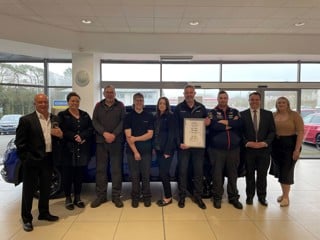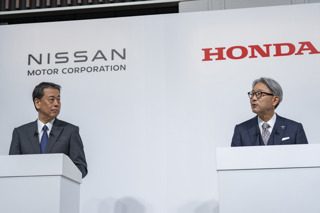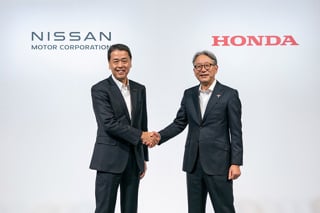[gallery id=1563]
David Hodgetts, who joined Honda UK as a production engineer 30 years ago and took over in his second stint as managing director in 2016, acknowledges that some things could have been done better.
Although Honda’s first-quarter registrations were up 2.1% year-on-year, to 18,137 (in a market down 12.4%), Hodgetts clearly has work to do. Honda’s 160 UK car retailers are targeting an average return-on-sales figure of just 1% for the financial year to the end of April and the brand’s below-average performance in the NFDA’s Winter 2017/18 Dealer Attitude Survey result indicates discontent in the ranks. Retailers rated Honda 4.9 out of 10 overall in the annual NFDA survey – down on the Summer 2017 score of 5.6 and an average of 5.3.
[gallery id=1563]
Focusing on small cars after the recession and a move away from EVs that left it without a “foot in the door” are just two of Honda’s mistakes over the past decade, according to its UK boss.
David Hodgetts, who joined Honda UK as a production engineer 30 years ago and took over in his second stint as managing director in 2016, acknowledges that some things could have been done better.
Although Honda’s first-quarter registrations were up 2.1% year-on-year, to 18,137 (in a market down 12.4%), Hodgetts clearly has work to do. Honda’s 160 UK car retailers are targeting an average return-on-sales figure of just 1% for the financial year to the end of April and the brand’s below-average performance in the NFDA’s Winter 2017/18 Dealer Attitude Survey result indicates discontent in the ranks. Retailers rated Honda 4.9 out of 10 overall in the annual NFDA survey – down on the Summer 2017 score of 5.6 and an average of 5.3.
Hodgetts believes the way to win retailers’ hearts is by delivering increased profitability. Whether this is possible in a year where Brexit uncertainty, possible further interest rate rises and rising inflation are dampening consumer confidence is another matter.
“The NFDA’s Dealer Attitude Survey can be ranked on profitability, or as a result of attitudes that ‘it used to be better’.
“I think the dealers with quite a few manufacturers, in particular, have a broader view of just how things are industry-wide,” said Hodgetts, indicating that the bosses of larger retail groups may be more pragmatic about Honda’s results at a time when business is tough across the board.
“The market this year is clearly going to be tough again. I don’t see anyone saying there’s much opportunity for making more profit in 2018.”
He added: “We totally acknowledge that some retailers will feel they aren’t making a good enough return from the franchise, but the curve of profitability shows that some of our dealers are making 6% return-on-sales and quite a lot of money.
“When we say an average of 1% return on sale, a lot of our retailers will say ‘well that’s not me’.”
Chasing profitability
Hodgetts said an average return-on-sale of 1% was “our minimum target”.
“We’re doing all we can to support profitability. Ultimately, 1% isn’t what we want for our network and I’m sure the network agrees with that.”
When he returned to the managing director’s chair in January last year after five years as Honda Motor Europe’s
corporate auditor, Hodgetts said he was keen to deliver transparency and generate realistic aspirations for retailers.
He told AM that the open debate heard in quarterly meetings with Honda’s national dealer council (NDC) was a credit to the efforts made by Phil Webb, Honda’s head of cars, and his team.
The NDC is chaired by David Cox, managing director of Cox Motor Group, and has nine members, but it also has a chairman and vice-chairman for each of Honda’s UK regions and includes representation from retail operations of all sizes, according to Hodgetts.
He said: “There’s a lot more constructive debate now than there was four or five years ago, when there was a lot of whingeing. You can understand why – we had just come through the recession and Honda, they thought, had dropped the ball. I think that’s probably true.”
He believes dealers probably think more realistically now: “I think they realise we only have a certain amount of margin to play with and we have to trim our cloth to suit.”
Hodgetts said there has been consolidation in the network in recent years, with fewer smaller operators – Vertu Motors is now its largest operator with 13 sites.
DM Keith was the latest AM100 retailer to join the network with the acquisition of Grimsby’s Westgate Motor Group in February. In November, Eastern Western Motor Group acquired Phoenix Honda’s Stirling site from the Phoenix Car Company, to take its Honda representation to three sites.
Hodgetts said Honda’s scale in the UK market still limits its ability to realise the operating efficiencies of some mainstream rivals.
“Broadly speaking, we’re happy with both kinds of dealer,” he said. “With 2% market share, we can’t have a hub-and-spoke model with administrative responsibilities and test cars centralised in a certain area, which can liberate operational efficiencies.”
Sales performance
While Honda’s 2017 registrations didn’t suffer as much as the likes of Citroen and DS (-23.26%), Vauxhall (-22.24%), Renault (-18.79%), Peugeot (-16.55%), Mazda (-16.13%), or Ford (-9.71%), in a market down 5.65% at 2.54 million, the arrival of a new Civic hatchback was not enough to arrest an 8.81% decline to 53,901 and its market share fell from 2.19% to 2.12%.
That is a far cry from the bold sales aspirations put forward in 2014 by then head of cars Leon Brannan, who predicted Honda would enjoy 80,000 annual registrations by 2017.
When Brannan made that forecast, UK Honda dealers (there were then 174 of them)had a three-car range, delivering 53,544 annual registrations and an average return on sales of 0.9%.
Hodgetts said Honda put a lot of effort into building a UK retail network capable of handling high volumes after its pre-recession highs – in 2007, more than 300,000 Hondas were registered across Europe, more than 100,000 of them in the UK.
![]() He said Brannan’s ambitious targets of 2014 may have been built on hopes of a return to that kind of performance, but added that a combination of economic issues and strategic errors with the Honda range line-up had left such goals out of reach.
He said Brannan’s ambitious targets of 2014 may have been built on hopes of a return to that kind of performance, but added that a combination of economic issues and strategic errors with the Honda range line-up had left such goals out of reach.
Hodgetts said: “Because of the recession, that all went horribly wrong. Honda’s ability to react to some of those changes was perhaps, in many ways, to re-trench a bit and be conservative about the market going into 2010 and 2011.
“We worried that people would go for lower-cost cars and thought that people wouldn’t want to buy sports cars, for example, and may just be prepared – in a recession – to focus on vehicles like the Jazz.
“I think, in hindsight, that was wrong. The market for sports cars didn’t go away. In fact, in many ways, it has continued to strengthen and that kind of brand image is crucial.”
Hodgetts said Honda’s post-recession conservatism led to a big reduction in the model range from 2010 to 2013: “It clearly isn’t a 10-car range anymore, it’s a five-car range.
“There have been points where there has been an ambition to get back to 80,000 registrations, but that ambition has to be matched by models.
“In the past, retailers would have been right to look at the range and say ‘well, what are you going to do to get it to that level?’”
Targeting performance
Over the past three years, Honda has generated more interest by placing a greater emphasis on flagship, performance products that were once pushed to the bottom of the brand’s agenda.
A new 310PS Civic Type-R was introduced in 2015, along with the re-introduction of the HR-V, a new Jazz hatchback and a
face-lifted CR-V SUV, with the flagship £130,000, 557PS, hybrid-powered NSX supercar following in 2016.
Early last year, the launch of a new Civic in Q1 was followed by another new Civic Type-R in September.
At the time of writing, Honda had sold 797 of the new £30,995 hot hatches, with London’s Chiswick Honda responsible for 106 sales of the NSX after the brand deemed it “unfair” to sell the car more widely due to the “immense” aftersales investment required from NSX dealers.
Hodgetts is clearly happy to see Honda’s motorsport heritage reflected in its showrooms, but expressed disappointment that the HR-V compact SUV has not delivered more. In 2017, 6,098 were registered, 16.07% down on 2016’s 7,266 and well behind Nissan’s 38,912 Jukes or Toyota’s 14,680 C-HRs.
“We have a fairly limited range of powertrains and the allocation from the factory has not been huge,” he said.
“The HR-V is very popular in America, which accounts for a lot of allocation, but production of that car will move to Japan later this year and that from that point onwards we do hope that we’ll be able to push the HR-V a little harder.”
Honda’s next performance push will come in the shape of vehicles that can drive down the brand’s emissions.
In Q4, a new CR-V – unveiled at March’s Geneva Motor Show – will usher in a new twin-motor hybrid and a cycle of product replacement that is expected to phase out diesel engines.
Hodgetts said: “During the current model run-outs, we will keep diesel in all our cars, so Civic will have a diesel engine for the next three or four years, but when we get to a full model change, in my view, we will change to petrol and hybrid.”
Re-opening the door to EVs
Honda plans to offer electrified vehicles throughout its range by 2030 globally and 2025 in Europe, but Hodgetts conceded “I don’t think we have kept our foot in the door” with EVs as the brand explored options for a zero-emission solution. Honda has now mapped out a four-stage plan, evolving through hybrid and plug-in hybrid to EV and hydrogen power.
“Clearly, Honda thinks [the future is] hydrogen, but I don’t think that’s going to happen until many, years away when we have genuine hydrogen cars available commercially that aren’t supported by manufacturers,” said Hodgetts.
“Then we have the chicken-and-egg infrastructure problem. We’re still some years away.”
However, the door to EVs is open again. The response to Urban EV and Sports EV concept cars has ensured that the Urban EV will enter showrooms in early 2020.
Voicing caution about the sales prospects and pricing for the vehicle, which is likely to offer a relatively short EV range for urban driving, Hodgetts said: “They will be very expensive cars.”
The brand plans to keep close tabs on the cost of any EV plans to UK retailers, with very limited requirement for charge points at first.
Discussions are taking place to outline plans for technician training, much of which now happens online rather than at the Honda Institute in Bracknell.
Retention and loyal customers
After Honda’s registrations declined from the heady days of 2007’s 106,018, new emphasis was placed on the requirement to retain customers.
The brand’s determination to maintain a market share over 2% will not sustain its dealer network alone, however, and Hodgetts described aftersales as “the most important part of the business”.
Retailers have benefitted from the return aftersales custom guaranteed by heavily subsidised five-year service plans integrated into the finance offer.
“From a service plan point of view, we’re aiming to get to 90% this year and we’re not far off now,” said Hodgetts.
“We recognised that if we wanted to build our penetration up we needed to do something significant and long-term. I think everyone’s really happy with it now.”
Many Honda retailers have kept their workshops full with warranty work following a recall related to the replacement of Takata airbags, but Hodgetts said he believed 2017’s 67.2% average overhead absorption could be maintained.
“Overall, aftersales is by far the strongest part of the Honda business. It’s the one thing I think our dealers rely on for its consistency above everything else.”
Improvements could be made in the provision of used cars to the retail network.
Thanks to its UK manufacturing operation in Swindon, the brand has a 4,000-vehicle fleet that it feeds back to retailers via online and physical auctions.
However, Hodgetts appreciates that retailers can only rely on a limited supply of one-year-old, sub-10,000-mile vehicles despite the clear demand, and profit, in older stock.
As such, there are no rules governing the array of vehicles a Honda retailer can stock on their forecourt, with customers drawn to rival brands hailed as “potential conquests”.
In fleet, Honda continues to strengthen its proposition – 104 sites are now classed as Platinum Partners, meeting standards set by Honda UK fleet sales operation manager Marc Samuel and his team.
Glyn Hopkin became Honda’s 100th Platinum Partner retailer in July last year.
Dealer principals, sales managers and sales advisers undergo specialist fleet and corporate training and retailers are required to offer 48-hour test drives to business customers as part of the scheme.
Hodgetts claimed that, despite 48.67% of its registrations (26,234) coming from fleet last year, Honda remained “nowhere near the industry average in corporate/retail split”, but added: “We’re doing it in a way that’s manageable for us.”
The Brexit question
Addressing the media outside 10 Downing Street in February, following a meeting with Prime Minister Theresa May, the Japanese ambassador to the UK, Koji Tsuruoka, said international companies could close their UK operations if there was “no profitability” in staying in the country.
Hodgetts insisted that Honda’s Swindon plant remains central to the manufacturer’s plans in the UK.
He held the post of division manager of production planning and logistics between 1998 and 2005 – a time of considerable growth at the plant – and believes its future looks bright, despite the prospect of Brexit.
“I kind of think of (the Brexit vote) in a slightly insular way – it’s not that bad for Honda UK. We have some major advantages now that we didn’t have before,” he said.
“We have a situation where our factory in Swindon is back to full capacity because we’re making half our cars for the US market.
“We make solely Civic and from this year. That might sound a shock, but it’s hugely efficient in terms of scale. The market in the US is very strong for the Civic.”
In 2011, 97% of the Hondas sold in the UK were built at Swindon.
Honda’s new global manufacturing strategy will also mean more vehicles heading to the UK from Japan, which should move retailers here up the queue for new product launches, according to Hodgetts.
The current strength of the yen and the prospect of a free trade agreement between Japan and the EU, which he hopes will be emulated and delivered with greater speed by the UK post-Brexit, should also make Honda’s range cheaper and more profitable.
Hodgetts said: “In the UK, you could say that we are no worse off from a dealer perspective because there are no tariffs from Civic and there are no higher tariffs on the cars from Japan.”
Login to continue reading
Or register with AM-online to keep up to date with the latest UK automotive retail industry news and insight.


















Irishboy4 - 03/05/2018 13:44
I owned three Honda dealers in the UK, our ROS was 2.5%. It was the best of franchises, but held back by a market perception that they were cars for old people. If they can get round this view then younger buyers will increase the share. The irony is that vw group now have over 50% of the UK market and they defrauded over one million buyers with the dieselgate scandal. Bizarre as Honda are British and people are buying vws made in Germany, India and South Africa.